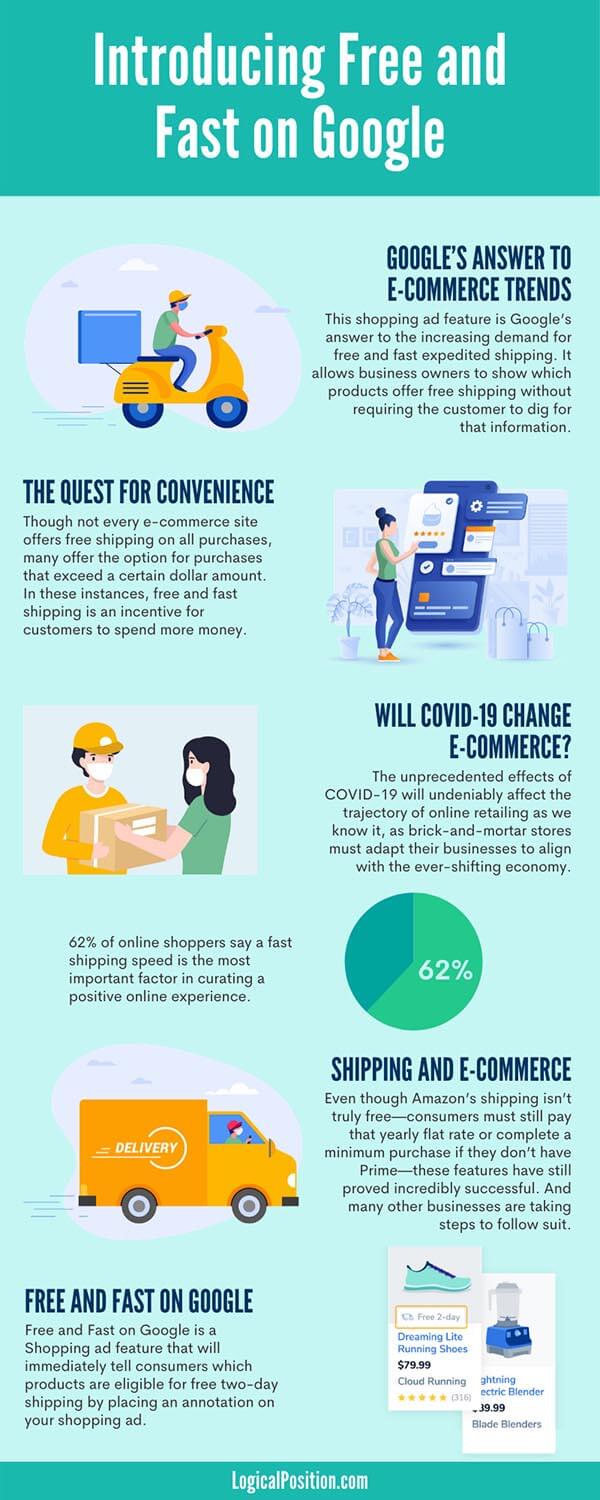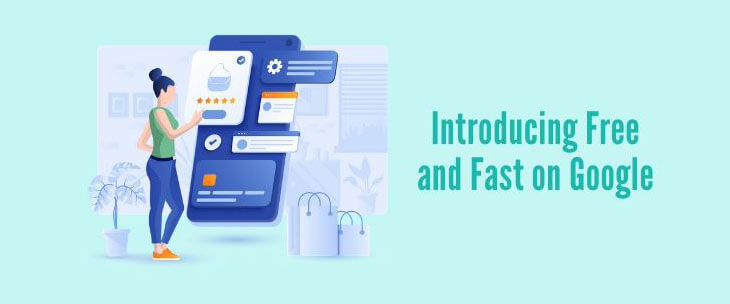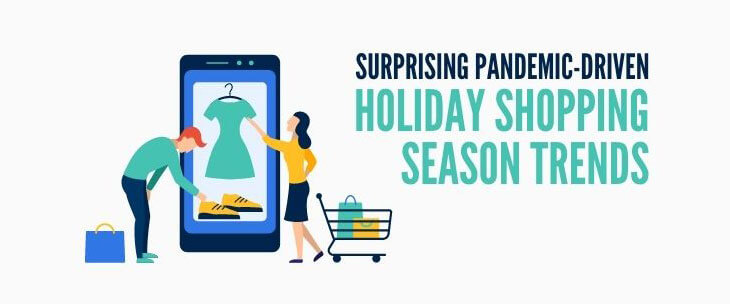Google’s Answer to E-Commerce Trends
Earlier today, Google officially launched a shopping ads feature that will help retailers quickly answer the first question many consumers have: does this item ship for free? The second question is: how long does it take? An astonishing number of people have come to expect timely and free shipping, and this expectation greatly affects their purchasing process. Over time, free two-day shipping has become less of a luxury and more of an expectation, which is why it’s a valuable advertising tool for businesses that offer it.
Google’s Free and Fast is a Shopping Ad feature that will immediately tell consumers which products are eligible for free two-day shipping by placing a badge on your shopping ad. The importance of such tools for e-commerce has increased throughout years of customer shopping experiences. To properly understand why Google has developed this tool, we must identify how consumer shipping expectations are continuing to change retail. This starts with taking a look at how several decades of online shopping has created a demand for convenience.
The Quest for Convenience
Nearly three decades of online shopping have taught us that a convenient shopping process is entirely possible. People can now do their shopping while sitting on the couch and watching their favorite TV shows. They like finding what they need in a matter of minutes and having it shipped that same day. They don’t like to find that they must pay $15 to get something in two days.
Did people always have this expectation? Well, no. In early 2001, Amazon began offering free shipping on all orders that exceeded $99, eventually lowering the required amount to $25. In 2005, they launched Amazon Prime, which—for a yearly fee—allowed subscribers to get free two-day shipping on all orders. The success of this program drove competitors to come up with their own shipping incentives. Marketplaces such as Etsy also began to encourage their retailers to win customers through free shipping.
Though not every e-commerce site offers free shipping on all purchases, many offer the option for purchases that exceed a certain dollar amount. In these instances, free shipping is an incentive for customers to spend more money. In cases where customers are already making a purchase of more than, say, $35, they’re likely expecting free shipping. If the site they’re shopping on doesn’t offer it, they are more likely to abandon that cart and look elsewhere.
Will COVID-19 Change E-Commerce?
In 1994, Pizza Hut made their first online delivery. In 1995, Amazon sold a book for the first time. In 2004, Facebook started profiting from ad revenue. These events represented steps in the evolution of e-commerce—and we’re standing on another one of those steps as we speak. The unprecedented effects of COVID-19 will undeniably affect the trajectory of online retailing as we know it, as brick-and-mortar stores must adapt their businesses to align with the ever-shifting economy.
Small Businesses and the Value of E-Commerce
Amazon and eBay may seem like the behemoths that pioneered e-commerce as we know it today, but they certainly aren’t the only players on the field. Small businesses are staples in the economy, and they can gain a lot from presenting online options to their customers. Business owners who run their entire businesses online can avoid the costs associated with physical storefronts. They can also better collect statistics, more easily expand their customer bases, and provide superior customer service—along with a litany of other benefits.
What Shoppers Expect from E-Commerce
As e-commerce has grown, so too have customer expectations. It’s important that we keep an eye on the trends and maintain a true understanding of what customers expect from e-commerce sites. In a competitive online world, failure to meet these expectations can result in thousands of dollars’ worth of lost sales. The following statistics represent what customers consider important factors in curating a positive online experience:
- 62% say a fast shipping speed
- 54% say an easy delivery process
- 53% say ample information about products (videos, pictures, et cetera)
- 50% say an easy and fair return policy
- 40 to 46% say an easy purchase process on mobile and desktop
- 40% say friendly and experienced customer service reps
From Storefront to Homepage
Some small businesses are making the decision to completely shift their focus to e-commerce, while others are choosing to use it in conjunction with their physical stores. Adjusting to the changes will take time, but it gives businesses the opportunity to forge new paths to success. Introducing your business to e-commerce has a few key benefits:
- A greatly expanded customer base
- The ability for consumers to shop 24/7
- Easier growth of brand visibility
- Consumers may be more likely to shop from the comfort of their own homes.
Making the Transition
The transition will be a lengthy one, but businesses should know where to lay their foundations. A brick-and-mortar store must create an attractive storefront—for e-commerce, this storefront is your website. Therefore, businesses may want to take this time to look at their websites and determine how they can make them comparable to those of their competitors. Your website should be easy to navigate and optimized for SEO, and it should include professional photos of your products.
Grocers aren’t likely to switch to e-commerce in a traditional sense, but many are recognizing the benefits of offering food delivery services at this time. Many grocers are collaborating with companies such as Shipt to make the transition to the online world, delivering their products straight to the shopper.
Shipping and E-Commerce
Free shipping has become the norm. Some have dubbed this as “the Amazon effect.” Businesses recognized when we began entering a time of instant gratification: immediate responses to text messages; the ability to rent a movie from the comfort of a couch; and even the time and effort saved with coffee pods. Even though Amazon’s shipping isn’t truly free—consumers must still pay that yearly flat rate or complete a minimum purchase if they don’t have Prime—these features have still proved incredibly successful. And many other businesses are taking steps to follow suit.
Small businesses recognize they have something to contend with when competing with larger corporations, and the question of shipping is one of them. As we stated before, shipping hugely affects the decision-making process in the customer’s purchasing funnel. Small businesses must recognize that even Amazon ultimately doesn’t offer true free shipping and that they can still offer free shipping without incurring too many costs. Requiring a minimum purchase to qualify for free shipping is a safe method that ensures a purchase without putting a substantial dent in your margins.
Free and Fast on Google Shopping Ads
This Shopping ad feature is Google’s answer to the increasing demand for free and fast shipping. It allows business owners to show what they have to offer without requiring customers to dig for answers. This feature gives participating businesses a badge in the SERPs results, allowing consumers to immediately determine who will offer free shipping on a particular timeline.
This extension provides small businesses with the opportunity to compete with larger retailers by advertising that they, too, offer free and fast shipping services. Many consumers are more inclined to shop at small businesses, and this will give them even more of a reason to patronize them. The badge helps break down the wall between the SERPs and the business’s homepage by giving searchers an immediate reason to click. We believe that Free and Fast will have a notable impact on how online shopping continues to evolve.
Beta Results
Google ran a beta program to evaluate performance. Participants in this program saw a 7% increase in conversions, a 9% increase in CVR, and a 10% increase in conversions per dollar conditioned on impressions.

Logical Position and Free and Fast
Logical Position is happy to have been one of Google’s two pilot agency partners who enabled merchants on the Free and Fast ads feature. This means Logical Position is highly equipped to help you get started and make your products stand out. We encourage you to reach out with any questions and to learn more details about how Google Free and Fast can benefit you.




